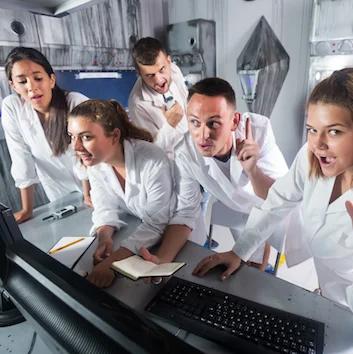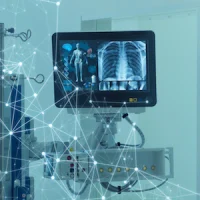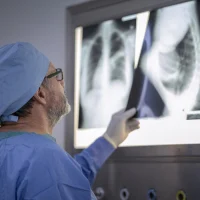The new University of Arkansas for Medical Sciences (UAMS) radiology residents recently found themselves locked in a room, working together to escape the clutches of a fictional crazy physician with hazardous nuclear materials.
This game is called an escape room, an activity that has become internationally popular as fun entertainment among groups of friends. The game is so popular that the one set-up during the European Congress of Radiology 2019 was 'sold-out' on the 2nd day of the congress. An escape room is a fun, safe space where 4-6 players try to discover clues and decipher puzzles in order to solve a mystery to escape a "locked" room.
You may also like: Gaming: Joy in radiology education
Physicians in the UAMS Radiology Department designed the escaper room which has attracted international attention. The idea for the escape room was planted after Dr. Kedar Jambhekar, associate professor of radiology and residency program director in the UAMS College of Medicine’s Radiology Department, visited an escape room in Boston. He shared his idea with Linda Deloney assistant professor and medical education director.
“We thought this would be a great team-building and educational activity for radiology residents,” Jambhekar said. “It seems so simple but it’s not,” he added, laughing.
Deloney, in turn, mentioned that Rachel Pahls, M.D., one of the senior resident physicians, is a gamer.
“So then I talked to Rachel and she said ‘Oh, that’s easy to do,’” said Jambhekar.
Deloney then wrote a grant proposal for the Association of University Radiologists/ Association of Program Directors in Radiology and they received a $5,000 Jerome Arndt grant from the Association of Program Directors in Radiology. Using the grant, they hired Wero Creative of Toronto, a company that builds escape rooms. Pahls designed the content of the game while Wero designed the room.
“We were able to create the escape room in time to use it during our boot camp for new radiology residents in July,” Deloney said.
The portable, hour- long game uses small props including lanterns, a skeleton, a view box, a small, portable ultrasound machine, boxes with number code locks, photographs and charts. The game masters, Pahls and Jambhekar, can view and communicate with the participants, by video chatting via Facetime or Skype. The participants can ask for up to three clues.
The challenge includes clues and various puzzles to solve, from crosswords, riddles and search-and-find challenges to identifying photos or images and answering trivia questions. Each clue leads to the next until all the clues are collected and the team is able to escape the room.
“We tried it out first with some really smart faculty members and some senior residents,” Pahls said. “Then we held it for first- and second-year residents.” Four teams, totaling 20 UAMS residents, have experienced the escape room so far and the plan is to hold the challenge for the students annually.
In addition to a team-building experience and educational avenue, the challenge gives administrators insight into which students are leaders or followers and who gets upset easily and who keeps their cool.
“The game also evokes a lot of friendly rivalry among the students wanting to know which teams completed the challenge the fastest,” Pahls said. The students were surveyed before and after the experience.
“Their feedback was extremely positive, confirming that millennial learners prefer learning experiences that are active, innovative, and social with high expectations and immediate feedback,” Deloney said. She said they value working in teams, being engaged and interacting with their instructors and material, and they are motivated by achievement and affiliation. “And they thought it was fun!”
The game, using a computer and several paper-based challenges, teaches some basic facts about radiology as a medical specialty. “Gaming in the academic world is being used more often as a learning tool among the millennials,” Jambhekar said. “There was already a lot of Jeopardy-type games being played, but an escape room is something unique.”
“We hope to prove the escape room helps increase a student’s grit,” Pahls said, referring to the students’ experience and heartiness.
“As part of the grant, we’ll share it with other universities,” Jambhekar said, adding that the plan includes providing an instructor’s guide for others who may want to replicate it.
“We’ve already been communicating with Johns Hopkins University School of Medicine, sharing information about it with them and we have the ball rolling for them to use it,” Pahls said, adding they met via video conference, walking those at Johns Hopkins through each step, sharing what objects were needed and the posters to print.
Jambhekar and Pahls are also considering holding it for students who have expressed an interest in radiology and building an escape room for other specialties.
“We’d use the same puzzles and mechanisms but instead of asking radiology questions, have clinical ones and redesign the clues,” Pahls said.
A radiology themed Escape Room game is an innovative training idea to help radiology interns transition into residency. Including team building activities has proven to enhance the development of camaraderie and helps provide support to new radiology residents to meet the challenges of the practice. Millennial residents require more active engagement, in and out of the reading room and prefer multimedia teaching tools. They want their educational experiences to have goal setting, to be relevant, provide them with feedback, transparency and autonomy.
Escape Rooms were held during orientation (BOOT Camp) for incoming radiology residents and for upper level residents and faculty with advanced content (four teams totaling 20 residents and faculty). They repeated the Escape Room 27 times for 144 residents from more than 10 countries at Radiological Society of North America (RSNA) 2018.
Players were engaged and competitive. They were able to connect the activity to their future responsibilities – analyzing knowledge under pressure (being on call), communicating effectively (conveying results and recommendations), having the dexterity and motor skills required for physical puzzles (hand-on procedures), being able to multi-task and come up with differential diagnoses under extreme stress and time pressure (being on call). A post-RSNA survey confirmed satisfaction with the activity, with overall enjoyment receiving the highest rating.
It is feasible to create a portable, inexpensive Escape Room as a novel educational platform for radiology residents. Combining knowledge-based challenges and technical skills in a live-action game simulated a real-life situation in which vital patient information must be collected and reported concisely and accurately. A Game Guide is available to program directors and medical educators upon request.
Image credit: iStock
References:
Latest Articles
Radiology, Residents, millennials, gamification, Academic Radiology, Educational games, University of Arkansas for Medical Sciences, UAMS
We created a radiology Escape Room, a competitive game where a team of players must discover clues and solve a mystery to escape a “locked” room. To succeed, players must collaborate and think critically and creatively. Our objectives were to provide a no










